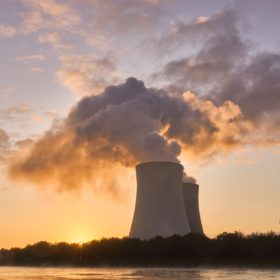
The latest edition of the World Nuclear Industry Status Report indicates the stagnation of the sector continues. Just 2.4 GW of new nuclear generation capacity came online last year, compared to 98 GW of solar. The world’s operational nuclear power capacity had declined by 2.1%, to 362 GW, at the end of June.
The levelized cost of energy (LCOE) from nuclear power rose from around $117/MWh in 2015 to $155 at the end of last year, according to the latest edition of the World Nuclear Industry Status Report, published annually by French nuclear consultant Mycle Schneider.
By contrast, the LCOE from solar power decreased from $65/MWh to approximately $49 and that of wind from $55 to $41.
“What is remarkable about these trends, is that the costs of renewables continue to fall due to incremental manufacturing and installation improvements while nuclear, despite over half a century of industrial experience, continues to see costs rising,” stated the report, citing a recent study from financial advisory and asset management firm Lazard. “Nuclear power is now the most expensive form of generation, except for gas peaking plants,” added the study, which did not provide an LCOE for gas peaker generation.
The cost difference is having a huge impact in new generation capacity deployment, with just 2.4 GW of new nuclear plants installed last year, compared to 98 GW of solar and 59.2 GW of wind, according to the report. The world’s operational nuclear capacity fell 2.1% to 362 GW by the end of June. “The number of operating reactors in the world has dropped … to 408 as of mid-2020, that is below the level already reached in 1988 and 30 units below the historic peak of 438 in 2002,” the study reported.
Six nuclear reactors were grid-connected last year: three in Russia, two in China and one in South Korea. At the same time, five nuclear plants closed last year and three more were shuttered in the first half of this year, with no nuclear facilities added from January to June. An additional eight facilities, which had ceased operations, were decommissioned in 2019.
“The ‘big five’ nuclear generating countries – by rank: the United States, France, China, Russia and South Korea – again generated 70% of all nuclear electricity in the world in 2019,” the report stated. “Two countries, the U.S. and France, accounted for 45% of 2019 global nuclear production, that is two percentage points lower than in the previous year, as France’s output shrank by 3.5%.”
The report added, the average age of the world’s nuclear reactor fleet has reached 30.7 years, with two-thirds of reactors operating for more than 31 years.
The number of reactors under construction rose from 46 to 52 – of which 15, with a total generation capacity of 14 GW, are in China. Most of those projects, however, have suffered years-long delays. Last year, construction started on four plants in China and one each in Russia and the U.K. and work began on a Turkish nuclear plant in the first half of this year.
Lắp đặt điện mặt trời Khải Minh Tech
https://ift.tt/2X7bF6x
0906633505
info.khaiminhtech@gmail.com
80/39 Trần Quang Diệu, Phường 14, Quận 3
Lắp đặt điện mặt trời Khải Minh Tech
https://ift.tt/2ZH4TRU
Không có nhận xét nào:
Đăng nhận xét